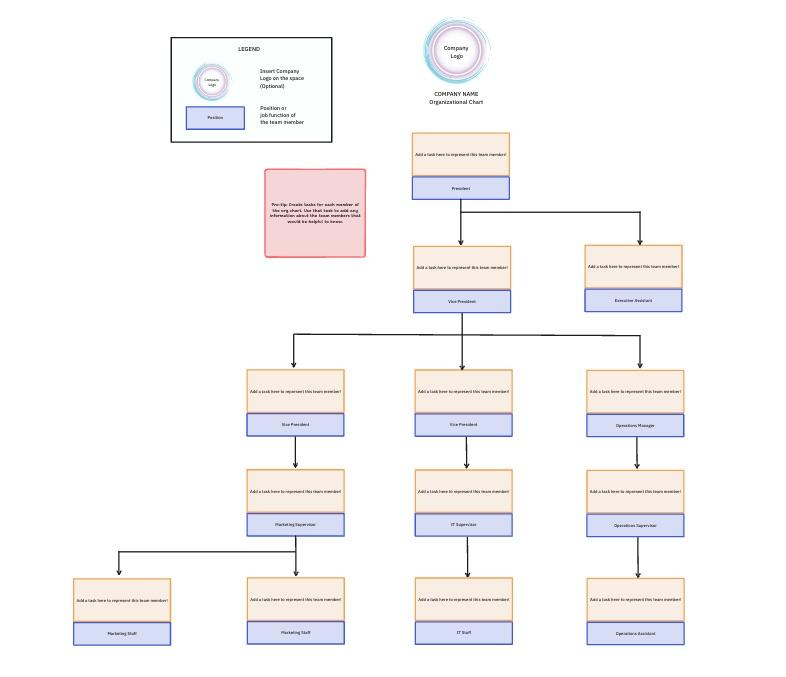Every team needs structure, but not every structure fits every team. As organizations grow, roles multiply, and workflows stretch across locations and time zones, clarity becomes non-negotiable. Without the right framework, even the most capable teams risk duplication, delays, or outright chaos.
That’s why organizational structure isn’t just a background setup. It’s a core part of how goals are met, decisions are made, and people work together.
Across industries, leaders are rethinking how their organization’s structure shapes performance. From small companies scaling fast to enterprises managing hundreds of roles, the need for clarity and coordination keeps rising. And as more teams shift to hybrid, distributed, or cross-functional setups, this challenge only deepens.
There are several types of organizational structures, each with its own logic. But one in particular remains widely used for its simplicity, control, and role clarity. It’s called the functional organizational structure and it’s what we’ll explore in detail next.
⏰ 60-Second Summary
Wondering how to streamline your teams and avoid structural chaos? Here’s how to build a functional organizational structure that actually scales:
- Group employees by expertise: using a structure that organizes teams into departments like marketing, sales, and human resources
- Strengthen accountability and clarity: through defined reporting lines, functional managers, and repeatable workflows
- Avoid common pitfalls: like siloed communication, rigid legacy processes, and overlapping responsibilities between departments
- Support growth and adaptability: by reviewing org design regularly, cross-training teams, and auditing workflows to remove friction
- Empower execution with the right tools: like Docs, Whiteboards, Mind Maps, Chat, Clips, Templates, and Task Management to keep work aligned with structure
Bring order, speed, and clarity to your organizational structure, no matter your size or setup.
How to Build a Functional Organizational Structure?
What Is a Functional Organizational Structure?
A functional organizational structure is a model where employees are grouped by their roles or specialized skill sets. Instead of organizing around products, markets, or regions, the structure focuses on functional departments like marketing, sales, operations, and human resources.
Each team then operates under a functional manager, and reporting lines flow vertically within that department. This model is built for expertise-driven execution and clear accountability.
Key features of a functional structure
The functional structure is designed to enhance control and focus by separating roles based on what people do best. Here’s how it works:
- Employees are grouped based on similar skills or job functions
- Teams operate as separate departments, each with a defined leader
- Reporting follows a clear hierarchy, often moving from middle management to top management
- Emphasis is on specific tasks within a function rather than cross-functional collaboration
- It supports decision-making at the departmental level, reducing ambiguity
This kind of organizational design promotes depth, quality, and standardization in execution. It’s particularly effective when departments have repeatable workflows and little need for constant cross-talk.
Comparison with other organizational structures
| Structure type | Key traits | When to use |
| Functional structure | Groups employees by job function with vertical reporting lines | When deep expertise, specialized skills, and standardization are needed |
| Flat structure | Few or no levels of middle management; broad spans of control | In smaller teams with high autonomy and informal communication |
| Hierarchical structure | Clearly tiered roles and reporting layers | In organizations requiring strict authority lines and oversight |
| Matrix structure | Employees report to both functional and project managers | In companies managing multiple projects across various departments |
| Divisional structure | Groups teams by product line, region, or market | For large companies with distinct business units or global operations |
This breakdown highlights how structure influences everything from resource allocation to speed of decision-making. Each model solves a different problem depending on team setup and business complexity.
Real-world examples of functional organizational structures
Many large companies still rely on the functional organizational structure for its stability and simplicity. For example:
- In healthcare, teams are split into clinical, administrative, and billing functions—each led by its own department head
- Manufacturing businesses often divide teams into design, quality control, production, and logistics, keeping operations focused
- Tech companies commonly separate engineering, support, marketing, and legal as independent units with their own workflows
These examples show how functional and divisional structures solve different problems. When tasks are repetitive and roles are clearly defined, a functional organizational structure can dramatically enhance efficiency and accountability.
Pros and Cons of a Functional Organizational Structure
Like any model, the functional organizational structure comes with trade-offs. It can drive remarkable efficiency in the right environment but introduce friction in others. Understanding both sides helps you decide if it’s the right organizational fit for your team.
Advantages of a functional organizational structure
The functional organizational structure works especially well when your business needs depth, consistency, and control. It’s a natural fit for companies that prioritize domain expertise and structured workflows.
Here’s what makes it effective:
- Deep specialization within departments: Teams focus on specific tasks aligned with their skill sets, improving quality and speed
- Clear career paths and reporting lines: Employees understand where they sit in the org chart, who they report to, and how they can grow
- Improved resource allocation: Workload and talent can be distributed strategically across functional departments
- Focused decision-making: Most decisions stay within the department, making the process faster and more aligned with team priorities
- Enhanced skill development: Repetition and mentorship within functions sharpen domain-specific expertise over time
- Operational efficiency: Departments function like well-oiled units—ideal for scaling without losing consistency
When managed well, this structure creates a culture of mastery, stability, and predictable performance.
Challenges of a functional organizational structure
Despite its strengths, this structure isn’t without friction. Especially when departments need to work together or respond to change quickly.
Common limitations include:
- Siloed communication: Teams can become disconnected, leading to poor inter-departmental communication and reduced visibility
- Limited cross-functional collaboration: Work tends to stay within departments, slowing down innovation or shared initiatives
- Overreliance on functional managers: A single department head can become a bottleneck if they’re stretched too thin
- Lack of agility: Functional models can be rigid, especially when adapting to fast-changing projects or markets
- Conflicts between departments: Competing priorities often arise, especially in matrix organizations or businesses with overlapping workflows
- Reduced visibility into the entire organization: Employees may not understand how their work connects to broader company goals
In some cases, companies introduce dual reporting relationships or hybrid models like the matrix structure to balance this rigidity. These allow for more cross-departmental collaboration without abandoning the functional model entirely.
How to Create a Functional Organizational Structure?
Building a functional organizational structure isn’t about sketching an org chart and calling it a day. It’s a strategic process that requires clarity, collaboration, and alignment across leadership.
You’ll need to identify what roles your business actually needs, how teams should be grouped, and who makes decisions at each level.
Let’s walk through the process step by step.
Step 1: Define your organization’s core functions
Before assigning titles or reporting lines, you need a clear understanding of your organization’s essential business functions. These are the foundational areas your company relies on whether it’s product development, marketing, finance, sales, or customer support.
Start by mapping out what your company does, not just what it calls things. Different departments often overlap, so this stage is about defining responsibilities and not job titles.
Key questions to ask:
- What functions are critical to daily operations?
- Where does your team already have strong specialized skills?
- Are there any responsibilities that multiple people are sharing without clear ownership?
💡Pro Tip: With Docs, you can collaborate in real time with team members to brainstorm various functions, skill gaps, and areas of ownership. And with AI within Docs, you can refine this content, add suggestions, and summarize ideas.
Docs helps teams create structured, searchable knowledge that updates in real-time. Departments can collaborate on internal wikis, link Docs directly to tasks, and keep all process knowledge in one place—without jumping between tools.

Once your core functions are identified, group similar activities together. This creates the basis for your functional departments, which are the pillars of your future structure.
This step is foundational. It shapes how your organizational structure outlines will evolve and gives you the clarity to build teams around actual business needs.
Step 2: Assign leadership and define reporting lines
Once your core functions are defined, the next step is to determine who leads each department and how reporting flows across the organization. This is where a clear hierarchy becomes critical.
Start by identifying experienced team members who can lead with both operational and strategic oversight. These become your department heads, often functioning as functional managers who guide their teams, allocate resources, and oversee performance.
Here’s what this step involves:
- Define who’s responsible for each functional area
- Establish reporting paths from individual contributors up through middle management and top management
- Clarify how decisions will be made within departments and escalated when needed
- Ensure that no role reports to more than one manager unless you’re designing a matrix structure intentionally
💡Pro Tip: With Assigned Comments, simply “@” the functional head to your org structure Doc so that ownership is clear. You can also add them as watchers to the relevant List or project within , so they’re notified of all actions within the department.
This layer of the functional organizational structure ensures accountability without overcomplicating communication. When reporting lines are unclear, it often leads to delays, missed ownership, or duplicated effort.
Be mindful of balance here as functional departments shouldn’t become too top-heavy. Keep lines of authority tight but lean enough for speed.
Step 4: Establish communication and collaboration norms
A functional organizational structure works best when each department performs at its peak. But even the most efficient team can underdeliver if it doesn’t collaborate effectively across functions. That’s why establishing communication and collaboration norms is just as important as setting up reporting lines.
Cross-departmental visibility can make or break execution. If marketing doesn’t understand sales priorities or if operations aren’t aware of product delays. Then teams end up working in silos. To prevent that, align department heads regularly, set up structured check-ins, and make it easy to escalate when input is needed from other departments.
While every organization’s communication style is different, there are a few constants:
- Clear expectations around when and how updates are shared
- Defined handoff points between functions like sales and customer support
- Agreed-upon escalation paths when collaboration breaks down
💡Pro Tip: Chat takes real-time, contextual communication to the next level. You can create Chat channels right from within a project or List, assign comments in Chat, create Tasks using AI within Chat, and lots more. Avoid siloes,


It’s not just about fixing breakdowns; it’s about preventing them.
This step also plays a key role in your organizational design long-term. By reinforcing habits of open communication and shared ownership, you make it easier to grow without losing alignment. Even as your team expands, these norms act as anchors that keep execution connected and cohesive.
Step 5: Standardize documentation and knowledge sharing
Structure without clarity doesn’t scale. Once teams are in place and communication lines are drawn, the next step is to document how work gets done so knowledge is consistent, accessible, and repeatable across the entire organization.
When every department runs on different assumptions, even a well-built structure starts to break down. The solution? Standardized documentation and shared systems of record.
Build a centralized knowledge base
Each functional department should maintain living documents that outline its core processes, recurring workflows, and departmental guidelines. This removes ambiguity, speeds up onboarding, and keeps execution consistent even when roles shift.
- Document decision-making processes so nothing gets lost in verbal updates
- Outline role expectations and team responsibilities
- Keep SOPs version-controlled and accessible across multiple departments
Here, offers the perfect solution. AI Knowledge Management serves as the central brain of your organization. Your team benefits from Connected Docs, wikis, and the world’s most complete Work AI, yielding instant answers and ensuring that company knowledge is always available.
Capture and share institutional knowledge
Written documentation is essential—but sometimes, context is easier to share visually. Whether you’re walking through a report, explaining a workflow, or reviewing a process issue, quick video explainers often work better than long text blocks.
That’s where tools like Clips come in. Managers and team leads can record short, on-screen walkthroughs to clarify handoffs, updates, or recurring problems. No meetings are needed. Just clear context shared instantly.


This kind of visual knowledge-sharing reinforces transparency, reduces back-and-forth, and supports teams that operate asynchronously.
When documentation and knowledge are standardized, it removes friction from every level of your functional organizational structure. People know where to find answers, how to execute, and what’s expected, without constant clarification.
Step 6: Employ tools and resources for building organizational structures
The success of any organizational structure doesn’t stop at design. You need the right tools to support it. These tools let you visualize, document, communicate, and execute across every department. Without them, even the most carefully built structure starts to bend under pressure.
Map your structure visually and collaboratively
In the early stages of structure design, alignment is everything. Leaders need to see how roles connect, where reporting lines fall, and which departments need more clarity.
Whiteboards make this possible. You can map out functional areas, draw reporting relationships, and work through iterations with department heads in real-time. It’s far easier to identify gaps or overlaps when you can see the whole system come together visually.
Once you’ve explored options, you can move toward a formal layout using the Organizational Chart Template. It helps you:
- Build a clear, editable hierarchy using pre-structured role blocks
- Collaborate across teams without getting lost in formatting
- Update reporting lines quickly as departments evolve
It acts as a bridge between brainstorming and structure without needing to rebuild anything.
Clarify departmental purpose and ownership
After finalizing the structure, each function needs clear accountability. That means documenting who’s responsible for what when work overlaps across multiple teams.
Mind Maps help you lay this out. You can visualize connections between people, teams, and workflows, making it easier to define scope without creating bottlenecks.
Once responsibilities are mapped, the Project Management Roles & Responsibilities Template makes ownership concrete. It lets you:
- Define who’s accountable for specific tasks or deliverables
- Document handoffs and responsibilities by team or role
- Avoid role confusion during onboarding or cross-functional work
Templates like this don’t just save time but also preserve clarity as the structure scales.
Connect structure to daily execution
Structure isn’t just for leadership, it has to show up in the way work gets done. That means connecting your org chart to task management, documentation, and communication.
Tasks lets you assign deliverables by role, department, or strategic goal. Work becomes traceable, measurable, and aligned with your organizational model.
Use Docs to house process knowledge, departmental SOPs, or onboarding guides. Then use Clips to walk through changes or clarify workflows visually, especially helpful for async or distributed teams.
Evaluate structural effectiveness with people data
Once your structure is operational, you need to know whether it’s actually working. Visuals and reporting lines are just the surface. Real insights come from how people perform within the system.
That’s where human resource metrics become essential. Tracking the span of control, team productivity, engagement levels, and headcount ratios can tell you if a department is overextended or if certain roles need to be redefined.
Performance appraisal systems also help flag structural misalignment early. If one team consistently hits targets while another struggles, it may not be a skills issue. Rather it could be a sign that the structure itself needs adjusting.
The right evaluation tools don’t just measure people, they reflect how well your organizational structure serves them.
Overcoming Challenges in Functional Organizational Structures
No structure is immune to friction. As businesses scale or shift, even a well-designed functional organizational structure can reveal blind spots, specifically if it’s left unchecked for too long.
Here are four challenges that tend to surface, along with strategic ways to address them.
1. Overlapping responsibilities between departments
When job functions are defined within silos, boundaries can blur. A marketing analyst starts handling sales enablement. An ops manager ends up troubleshooting IT issues. While this might seem helpful in the short term, it often leads to duplicated efforts or missed accountability.
Why it happens: Departments evolve, and roles expand organically but without updated role definitions, responsibilities get passed around informally
How to solve it?
- Revisit role scope regularly, especially after structural or personnel changes
- Involve department heads in reassigning responsibilities intentionally, not reactively
- Audit recurring workflows to identify areas where responsibility is unclear or shared unnecessarily
Clearer role lines reduce confusion and protect efficiency without boxing teams in.
👀 Did You Know? The world’s first organizational chart looked like a tree! 🌳
Created in 1854 for the Erie Railroad, it had the board of directors at the roots and operations branching outward like limbs.
2. Poor adaptability during organizational change
Functional structures are excellent for stability but not always for speed. When market shifts demand quick reconfiguration, these structures can feel like turning a container ship. Resistance to change slows down strategic pivots, product rollouts, or M&A integrations.
Why it happens: Because decision-making and execution are deeply rooted within functions, shifting direction often means unraveling embedded processes across departments
How to fix it?
- Create structural flexibility through temporary cross-functional teams
- Train middle management to lead through change, not just process
- Build in review points to assess whether the structure still matches the strategy
The structure should support evolution and not stand in its way.
3. Dependency on legacy workflows
What once made the structure efficient can later become the reason it stagnates. Teams continue with outdated approval chains, redundant forms, or unnecessary checkpoints—not because they’re needed, but because “that’s how it’s always been done.”
Why it happens: Functional models favor repeatable workflows, but without regular cleanup, legacy systems build up around them
What to do?
- Conduct annual workflow audits to trim outdated steps
- Involve front-line teams in identifying friction points
- Sunset internal processes that no longer serve business outcomes
Optimizing structure doesn’t always mean redesigning it, though. Sometimes, all you need to do is remove what no longer works.
4. Slow onboarding and skill development in specialized teams
A deep functional focus can narrow visibility. New hires may master their immediate role but remain disconnected from how the rest of the organization operates. Over time, that slows onboarding, cross-training, and even promotions.
Why it happens: Functional departments often prioritize task execution over context. o skill development stays limited to immediate responsibilities
How to improve it?
- Build onboarding programs that include exposure to other departments
- Encourage interdepartmental mentoring or shadowing
- Define career paths that combine functional mastery with a strategic range
When employees understand the bigger picture, they contribute more meaningfully—without leaving their lane.
Rethink Structure, Realign Success
Getting your functional organization structure right is an ongoing strategy. Whether you’re managing multiple departments, building organizational charts, or navigating between a matrix organizational structure, a divisional organizational structure, or a hierarchical organizational structure, the key lies in aligning people, process, and purpose.
By clarifying department managers, empowering team leaders, and improving decision-making processes across functions, you create a system that supports growth. Prioritize organizational design that adapts to change, strengthens upper management, and fosters open communication across various departments.
Looking to streamline everything from role definition to resource allocation? Try today and bring clarity to your organizational structure at every level.


Everything you need to stay organized and get work done.















